The Giro d’ombre is the Venetian equivalent of a pub crawl. Needless to say, this being Italy, there is plenty of food to enjoy along the way. Venice native Sara Scarpa is your guide…
Photos by Iain Reid
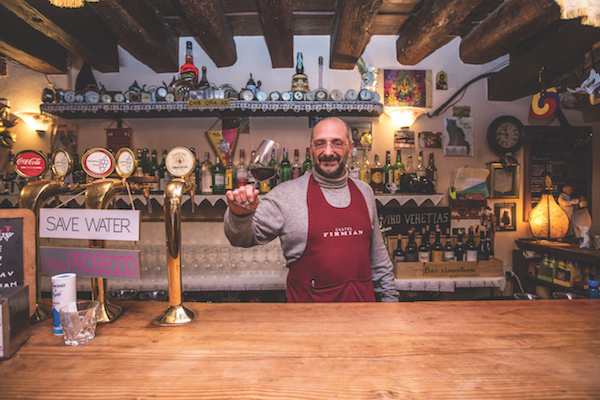
We were standing at the bar enjoying a plate filled with some baccalà mantecato (dried salt cod), a few polpette (fried meatballs) and some sardee en saor (sweet and sour sardines), to be washed down with an ombra de vin (a ‘shadow’, or small glass, of wine). The place was relatively quiet as it was still too early for a sit-down lunch, but the atmosphere was friendly and cosy.

We were chatting to the hospitable owner and to a charming local Venetian painter, one of their regulars, who was sitting at the bar on his own. I suspect this has been his seat for many a year. Our conversation touched on wine, took in the do’s and don’ts of meatballs, skirted around the cruise ships that descend on the city – and ended up with a discussion of art! We were provided with a quick insight into the artist’s work by viewing his paintings on the owner’s iPad and, in the end, we showed so much interest in his art work that we received an invitation to see it first hand in his studio.
Interesting encounters like this are one of the reasons I love to frequent these places. So many pleasant conversations take place in the many osterias across Venice, and for me this is one of the true remaining experiences of Venice – the scale of the history, the scandals and espionage that have taken place in such hostelries, really fire the senses. Unlike the infamous casinos, which have mostly fallen into a forgotten past or have been incorporated as deluxe hotels, many of the osterias, though they may have changed in name, have generally stood on the same sites for centuries, just like the churches that adorn the city.
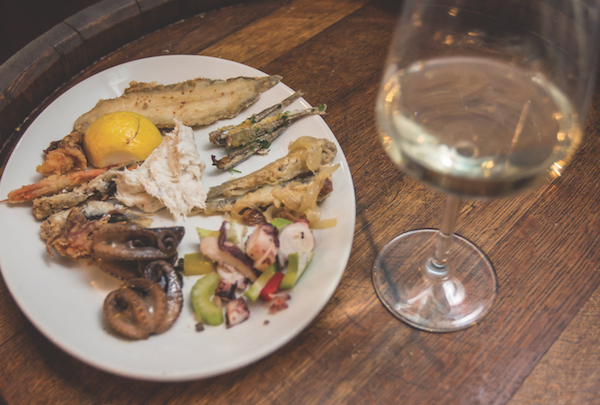
At the fish market
With its low ceilings with wooden beams, a long, narrow wooden counter, paintings, prints and photos on the walls, a friendly host and dozens of appetising cicchetti (little snacks similar to Spanish tapas), Antica Osteria Ruga Rialto is always one of our favourite stops after our errands just before lunch.
That morning, like so many other people, we had spent some time at the Rialto fish market, carefully selecting the freshest fish for our dinner – branzini (sea bass), orate (sea bream), capesante (scallops) and granceola (spider crab). On our way home, an ombra is like a ritual for us. We enjoy popping into some of our most-loved osterias in Rialto to graze on some cicchetti before having a proper lunch. Many times, however, the stops are more than just a couple and the cicchetti turn out to be our main meal!
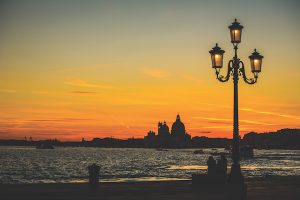
After living for so many years in London, though I have truly come to love that city, there are still many things I deeply miss about my home town, and the giro d’ombre is certainly one of them. Today more commonly known as a bacaro tour, this is basically a pub crawl in Venice, where the pubs are replaced by osterias. However, the big difference between the two tours is that, as always happens in Italy, drinks are never disassociated from food and therefore every glass of wine is always religiously accompanied by some delicious cicchetti.
People have always drunk lots of wine in Venice – they say the habit was partially derived from the fact that in the past, drinking water was really expensive due to its shortage (often the water from the wells was contaminated with dead animals).
Indeed, people here used to drink so much wine that many times the authorities tried to regulate or even stop the growth of the osterias. In 1317, for example, the Gran Consiglio decreed that the city had to limit their number to just 16. In much more recent times, at the end of the 19th century, the death rate for chronic alcoholism in Venice was the highest in Italy, and in 1910 there were still as many as 1,276 establishments selling alcoholic drinks in the city.
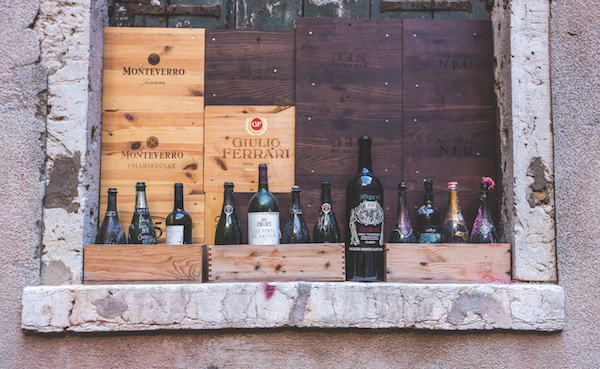
The wine industry
Numerous still are today’s signs that point to the importance of the wine industry in the city – Riva del Vin (Wine Embankment) in Rialto was where the wine barrels were off-loaded from the merchants ships and stored; the nearby Calle dei Boteri (Street of the Barrel Makers) was where the barrels were made; and the nearby Church of San Silvestro was where the wine traders had their patron saint.
If you look carefully, especially in Rialto, you can still spot the ingenious way Venetians overcame the dilemma of small Venetian doorways and large barrels of wine as they amended the door frame to mimic the shape of a barrel so it would simply roll through!
Andar par ombre has always been popular in Venice. The older male generations drank and nibbled, played cards with their friends, discussed serious matters or just chatted about trivial things. The osteria was the place where social and generational barriers were temporarily forgotten, where anyone with his or her captivating tales could be the protagonist and steal the scene for a few hours.

Throughout the centuries there have been different types of osterie or taverne where wine was sold – caneve, magazeni da vin, bastioni, malvasie, furàtole and bacari. Nowadays, the difference between osteria, trattoria and ristorante has almost been lost and unfortunately many traditional places have been turned into anonymous modern bars serving “international” panini. This is all part and parcel of the cosmopolitan feel of Venice these days, but I have to admit that I do miss the warm interiors with wooden rustic tables, straw chairs, dimmed lights and authentic local cicchetti.
These are some of the most popular original local cicchetti that you must try during your stay – mesi vovi co’ l’aciugheta (half an egg with anchovies), polpette con carne o tonno (fried meatballs with meat or tuna), folpeti (baby octopus), crostini col baccaeà mantecato (toasted bread with creamy salt cod filling), sardee marinae (marinated anchovies) and seppie fritte (fried squid).
But there are some other traditional cicchetti which are not as suitable for everyone’s taste which sadly are slowly disappearing; bovoletti, fegato alla veneziana (Venetian style liver), nerveti coe segoe (beef cartilage with onions), spiensa (beef spleen), tripa rissa (tripe).
The house wine
Remember to ask for un’ombra della casa (a house wine) as usually this is a good and affordable wine. Do not expect a fancy large wine glass, the ombra is traditionally served in a very small and stubby glass called a goto. Most of Venice’s wine comes from around the region – Veneto is one of the most important areas in Italy for wine production with over 90,000 hectares of vineyards of which over a third are acclaimed DOC.
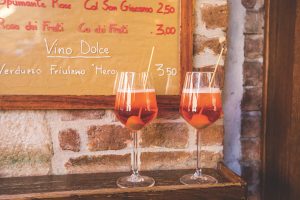
Together with the neighbouring regions of Friuli-Venezia Giulia to the east and Trentino-Alto Adige to the north, the Veneto regions forms a zone known as the Triveneto, which is well renowned for its fabulous wines. Just to name a few of the most loved ones: Soave, Pinot Grigio, Chardonnay and Prosecco if your preference is white; Valpolicella, Merlot and Amarone for the red.
If you happen to fancy an aperitif rather than just a glass of wine, then you definitely should order a Spritz, the classic Venetian drink which is a mix of Aperol (or Bitter Campari or Select), white wine (or prosecco) and a squirt of soda, served with a slice of orange and a green olive.
And don’t be afraid to ask people for advice. They will be happy to help and you never know who you will meet!
What is a giro d’ombre?
Although these days it is often known as a bacaro tour, I do prefer its old name, giro d’ombre (literally ‘tour of shadows’), as it references its history. Once upon a time, the winesellers in St Mark’s Square had to keep moving, following the shade of the tower, in order to keep their wine cool. The original name of giro d’ombre witnesses the fact that the ritual has been going on for centuries. Back in the 13th century the traders dealing in Rialto would not have had much time to sit down for lunch and would quickly stop for a drink and some food, just like the busy market-goers do nowadays.
Click here for Sara’s favourite giro d’ombre bars
